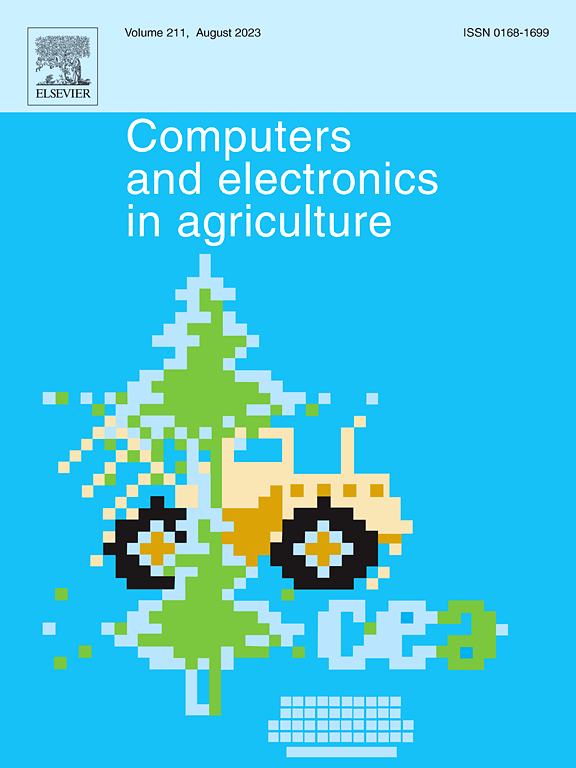标准营养液型鱼尾水肥机:设计、控制和决策
IF 8.9
1区 农林科学
Q1 AGRICULTURE, MULTIDISCIPLINARY
引用次数: 0
摘要
虽然用鱼尾水替代氮肥具有很好的应用前景,但鱼尾水含氮量波动较大,具有不确定性。因此,实现鱼尾水动态氮变化下的智能配置和有机替代是鱼尾水应用的关键。本研究以一种标准营养液为参照,提出了一种鱼尾水补氮补肥配施策略。为此,设计了一种基于动态智能施肥要求的智能施肥机。采用响应面法研究了该机器鱼尾水进水管流量、浓度比、吸力流量3个参数对营养液电导率(EC)稳定时间和液位目标时间的影响,建立了双目标函数决策模型。结果表明,基于机器配置的营养液和参比液EC值的均方根误差和均方误差均小于0.07246 ms/cm。这验证了提出的鱼尾水氮替代策略。此外,EC稳定时间和液位目标时间受三个参数的影响显著,其中肥料吸收流量和鱼尾水入口管道流量是最关键的参数。随后,利用建立的响应面模型,得到智能配肥机的最优工作参数:鱼尾水进水管流量= 1 m3/h,浓度比= 66,肥料吸收流量= 102 L/h。因此,本研究有助于实现鱼尾水的高效利用和氮肥的有机替代。本文章由计算机程序翻译,如有差异,请以英文原文为准。
Standard nutrient-solution-based fish-tail-water-fertilizer machine: Design, control, and decision
Although using fish tail water as a replacement for nitrogen fertilizers has excellent application prospects, the nitrogen content of fish tail water fluctuates greatly and is uncertain. Therefore, realizing intelligent allocation and organic substitution under dynamic nitrogen changes in fish tail water is pivotal for its application. This study proposes a nitrogen-replacement-fertilizer-dispensing strategy for fish tail water by using a standard nutrient solution as the reference. To this end, an intelligent fertilizer-dispensing machine based on the dynamic intelligent fertilizer-dispensing requirements is designed. The effects of three parameters, i.e., the inlet pipe flow of fish tail water, concentration ratio, and suction flow rate, of the proposed machine on the electrical conductivity (EC) stability time and liquid-level target time of the nutrient solution are investigated using a response surface method, and a double-objective function decision model is established. Results show that the root mean square error and mean square error of the nutrient- and reference-solution EC values based on the configuration of the machine are less than 0.07246 ms/cm. This validates the proposed nitrogen-replacement strategy for fish tail water. Moreover, the EC stability time and liquid-level target time are significantly affected by the three parameters, among which the fertilizer absorption flow rate and fish tail water inlet pipeline flow are identified as the most critical parameters. Subsequently, the optimal working parameters of the intelligent fertilizer-distribution machine are obtained using the established response surface model, as follows: the inlet pipe flow of fish tail water = 1 m3/h, concentration ratio = 66, and fertilizer absorption flow = 102 L/h. Thus, this study aids in realizing the efficient use of fish tail water and organic substitution of nitrogen fertilizer.
求助全文
通过发布文献求助,成功后即可免费获取论文全文。
去求助
来源期刊

Computers and Electronics in Agriculture
工程技术-计算机:跨学科应用
CiteScore
15.30
自引率
14.50%
发文量
800
审稿时长
62 days
期刊介绍:
Computers and Electronics in Agriculture provides international coverage of advancements in computer hardware, software, electronic instrumentation, and control systems applied to agricultural challenges. Encompassing agronomy, horticulture, forestry, aquaculture, and animal farming, the journal publishes original papers, reviews, and applications notes. It explores the use of computers and electronics in plant or animal agricultural production, covering topics like agricultural soils, water, pests, controlled environments, and waste. The scope extends to on-farm post-harvest operations and relevant technologies, including artificial intelligence, sensors, machine vision, robotics, networking, and simulation modeling. Its companion journal, Smart Agricultural Technology, continues the focus on smart applications in production agriculture.
 求助内容:
求助内容: 应助结果提醒方式:
应助结果提醒方式:


